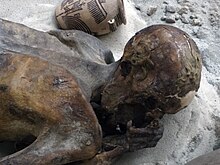35th century BC
| Millennium |
|---|
| 4th millennium BC |
| Centuries |
| Timelines |
| State leaders |
|
| Decades |
|
| Categories: |
|
Births – Deaths Establishments – Disestablishments |
The 35th century BC in the Near East sees the gradual transition from the Chalcolithic to the Early Bronze Age. Proto-writing enters transitional stage, developing towards writing proper. Wheeled vehicles are now known beyond Mesopotamia, having spread north of the Caucasus and to Europe.
Cultures

- Susa (Iran since 7000 BC)
- Uruk period (Sumer)
- Naqada IIb (Ancient Egypt)
- Early Minoan I
- Sredny Stog culture (final phase)
- Yamna culture (early phase)
- Cucuteni culture
- Vinča culture
- Megalithic Europe (Atlantic fringe)
- Nuragic civilization (Sardinia)
- Comb Ceramic culture
- Funnelbeaker culture
- Yangshao culture
Artifacts
Only approximate dating is usually possible for mid-4th millennium artifacts.
Events
- The Sahara desert starts to form from semi-arid savannah, through desertification.
- c. 3500 BC: First known zoo at Hierakonpolis.
- c. 3400 BC: Sumerian temple record keepers redesign the stamp seal in the form of a cylinder.
- c. 3500 BC: Pictographic proto-writing starts developing towards writing proper in Sumer, thus starting what is technically considered history.
- c. 3500 BC: The first monument of which there is still a trace (Duma na nGiall) is built on the Hill of Tara, the ancient seat of the High King of Ireland.[1]
- c. 3500 BC: Tin is discovered.
Sovereign States
See: List of sovereign states in the 35th century BC.
References
- ^ Memory and Monuments at the Hill of Tara by Erin McDonald, Chronika Journal
